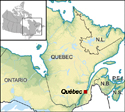Québec City's Environmental Services Adaptation Plan

Photo courtesy of Robert Saucier
LEADERSHIP AND TEAMWORK ARE KEY WHEN DEVELOPING ADAPTATION PLANS
Quebéc City (population 491 000) is located on the north shore of the St. Lawrence River in eastern Quebec. It is expected that climate change will result in the city being impacted by more severe weather events, including more intense snow storms, wind storms, heat waves and torrential rain.
In 2006, a presentation to City staff by Ouranos, a Quebec-based consortium on regional climatology and adaptation to climate change, spurred work to develop an adaptation plan. The City decided that, despite uncertainties in the magnitude of future climate changes, it was judicious to create an adaptation plan by examining past trends, climate projections, vulnerable operations and possible adaptive actions.
By being proactive, the City hoped to reduce the costs and negative effects of a changing climate on the City’s operations and infrastructure. The goal was to develop an adaptation plan for the City’s Environmental Services Department and then, based on the results of this small-scale trial, to produce an adaptation plan for the entire metropolitan area.
Environmental Services was chosen to develop the first adaptation plan because the department is responsible for managing the city’s natural resources in a sustainable manner and already had a good knowledge of climate change. Environmental Services has three main responsibilities:
- managing air, water and soil quality at facilities operated by public works – wastewater treatment plants, landfill sites, snow depots and stormwater management facilities
- managing the City’s trees and horticulture
- evaluating water quality (drinking and wastewater) in city-run laboratory facilities
An Environmental Services staff member led the process and wrote the plan. During the process, it was recognized that many actions already provided for in existing management plans could be considered adaptation measures because they serve to reduce vulnerability to climate hazards. Therefore, throughout the consultation process, staff were encouraged to identify both existing and new adaptation measures.
The process proceeded in four main steps over six months.
- Climate change projections To prepare for the consultations, a request was made to Ouranos to obtain regional climate modelling data for the 2020s, 2050s and 2080s.
- Literature review A literature review, encompassing scientific journal articles and government reports, was conducted to determine the likely impacts of climate change on the city’s physical infrastructure and natural environment, and to help create a methodology for developing the plan.
- Internal consultations Internal consultations were conducted with 10 Environmental Services staff members to identify existing and proposed adaptation measures. The outcome was a summary table capturing key actions for each of the department’s 20 subactivities.
- Prioritizing adaptation strategies Following revisions by the project lead, the summary tables were examined in individual meetings between the project lead and the consulted staff to arrive at a consensus on the final text and the priority level of each proposed measure.
The resulting adaptation plan, which was approved by council in April 2009, commits Environmental Services to consider the impacts of a changing climate in all of its operations, projects, plans and bylaws. In addition, the results from the consultations – including priority level, deadlines – and funding requirements – were presented in tables that clearly and concisely disseminate the key findings.
Eighty-eight adaptation measures have been targeted for all of Québec’s Environmental Services operations. The majority of these (54) target the aquatic environment and drinking water, areas of high vulnerability to climate change. Twenty-six measures have been defined as priorities, including 12 that had been planned but not yet implemented and 14 that are new strategies.
Adaptation Consultation
| A table was distributed to 10 staff members working on different subactivities within Environmental Services. The project lead filled in the climate change projections section based on research findings from Ouranos. The 10 staff members then completed the impacts and adaptation strategies sections. Below is an example of a completed table. | |
| Example: Drinking water | |
| Climate change projections |
|
| Impacts |
|
| Proposed/existing adaptation strategies |
|

Photo courtesy of Machael Rheault
The adaptation plan places highest priority on measures affecting the quality and availability of water, a vital resource that is particularly sensitive to changes in temperature and precipitation. The City is concerned about the projected increases in summer drought, which could make drinking water scarcer. Another concern is that rising sea levels, along with flow reductions in the St. Lawrence River, would result in salt-water intrusion impacting drinking water supplies in some parts of the city. While some of these issues may be already included in other City plans, the adaptation plan gives priority status to these issues.
The process that led to the development of the Environmental Services Adaptation Plan helped build support for the production of a city-wide adaptation plan. Following a clear presentation of some key climate change impacts and adaptation actions, the City’s Executive Committee approved (in April 2009) an expansion of the adaptation initiative to all of the City’s operations. Development of the expanded plan is possible through funding from the programme Climat municipalités of Quebec’s Ministère du Développement durable, de l’Environnement et des Parcs.
The consultation process and adaptation plan developed by Environmental Services is based on the understanding that proactive adaptation measures are generally more cost effective than reactive measures implemented after a significant climate impact has occurred. This example demonstrates the effectiveness of using a consultation mechanism to identify and prioritize adaptation measures and to develop broad-based support and ownership of adaptation initiatives.
Contact:
Matthieu Alibert
Division de la qualité du milieu, Québec Tel.: 418-641-6411, x2961 E-mail: matthieu.alibert@ville.quebec.qc.ca
Page details
- Date modified:
